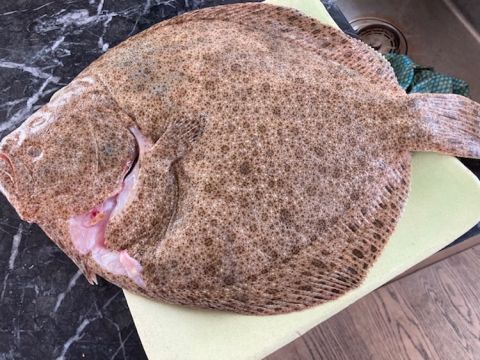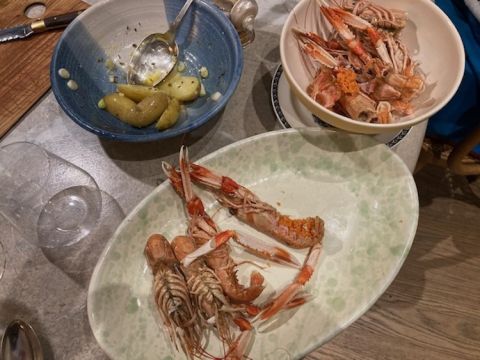This summer I lost my fear of langoustines.
I was never actually afraid of ordering them in a restaurant – although I have to say that on the pleasure/hard work ratio I always felt that it was the latter that slightly predominated. A great deal of sucking and poking around was necessary for not that much fulfilment. But today I will not have a word said against these pink beauties and I thought that, as the season gets underway (for Scottish langoustines it runs from September until May), I would share my new-found enthusiasm.
This enthusiasm was kindled one lunchtime in mid July, on a narrow backstreet in the small Languedoc village where we spend our summers. And it was definitely a Wednesday as that is the day when the fish van calls there, at exactly quarter to one.
The blue-and-white van with the painting of a large tuna on the side is from the Poissonnerie Conquoise, a small company from Conques-sur-Orbiel in the Aude department. Conques is not itself by the sea but it is not far from the Mediterranean and the whole region is a network of depots from which fresh fish and shellfish are delivered soon after being caught.
The van belongs to a man called Pierre, with a big smile, the odd tattoo and one earring, who spends his days driving around small villages such as ours selling fish, predominantly to French housewives. He must have a pretty regular routine. When he arrives, he hoots his horn several times. When, and if, customers arrive, he moves from his driving seat to the back of the van and opens up the side of it. Then he turns on his charm.
Pierre is one of those people who could, as they say, sell ice to the Eskimos, but he makes life a lot easier for himself by displaying his fish in style. There is tuna, monkfish, turbot, sacks of razor clams, packets of ready-to-eat dressed crab from Ireland, John Dory, skate wings, sole (though these are not Dover sole, sadly) and, often, gurnard. Given that the outside temperature is often over 30 °C, Pierre is always liberal with his ice, which he pours over the fish at frequent intervals.
For some reason, Pierre’s langoustines are always prominent, and this is perhaps the reason I bought them for the very first time. They were €3 each so €24 for eight. What could I lose?
I cooked them that night for our supper, boiled in heavily salted water for 3–4 minutes, alongside a salad of French beans, and an aïoli I had made (the ideal combination in my opinion), which we mopped up with the baguette left over from that morning’s breakfast. They really weren’t that difficult to eat, unpeeling the body of the fish and prising out the smaller flakes of flesh – so long as you don’t mind a bit of a mess. I, or should I say we, were hooked and I bought them again for just the two of us and then, two each, for a couple of friends as a first course.
I thought that once back in London my easy access to langoustines was over. There was no fish van, no Pierre, and therefore, I believed, no langoustines. But then came my weekly email from Henderson to Home.
I am indebted for the principal introduction to this fish supplier to our restaurateur son Will. Soon after lockdown had been enforced in London, Will mentioned that if I was on the lookout for top-quality fresh fish, this was the company to go to. Shaun Searley, the Quality Chop House’s estimable chef, had been buying from his namesake Shaun Henderson for several years. The company is 10 years old and has built up its clientele to approximately 70 other British chefs. But, like so many other restaurant suppliers, he suddenly found that he had, overnight, lost all his customers. He had to ‘pivot’, and Henderson to Home was born.
My first order was delivered to me in London at the end of April. Delivery was by bicycle ridden by a young man with a long beard, and the fish’s packaging was pretty basic. I remember unpacking it and thinking that I had to get it into our refuse system as quickly as possible.
My last order could not have been packaged more thoughtfully, more carefully or more differently. The turbot (above) and the Scottish langoustines (below, with detritus and new-potato salad, eight for £20) were each vacuum-packed inside an outer, looser wrapping that was marked recyclable. This came in a thick cardboard outer, again completely recyclable, which had a large crab and Henderson to Home stamped on it. On the top of the fish was a single, rather lovely, sheet of card with the outline of 23 different species of fish and shellfish (cleverly drawn by BiroBugs), with the two I had ordered, langoustines and a turbot, circled in black.
Over the intervening six months a great deal has changed at Henderson. Now that he has restaurant customers to deal with again, Shaun has handed over Henderson to Home to his Jerez-born colleague José Luis Coveñas, known to everyone as Pepe. (A fino or manzanilla is delicious with langoustines, after all.) His focus, plus growing demand, have combined to force Henderson to Home into a far more professional operation, as has their linking up with APC to ensure national distribution.
Their range of fish has broadened considerably but the quality remains the same high standard. And their logo ‘every order supports an independent UK fisherman’ cannot be argued with.
Home deliveries of langoustines and fish via www.hendersontohome.com.
Langoustines in restaurants
Whichever supplier any restaurant chef buys from, langoustines will always be an expensive item on any menu. At over £2 each that means a cost price of just over £8 for four; a serving of three looks a little mean to me. Then there is the cost of the sauce alongside plus the necessary implements, which translates to a menu price approaching £30. Why?
The first reason is that it is such hard work to catch them. This is done in a similar way to harvesting lobsters, using pots or creels that are laid on the seabed, where the langoustines scavenge for worms and small fish. Hauling up lobster pots can be a gruelling task, particularly when it takes place in the unforgiving and cold waters of the North Sea.
The second reason is that the langoustine population has been declining rapidly since the turn of the millennium. There are now very strict guidelines and quotas for catching them, issued both by the British government and by the European Union. Numbers available each year are strictly limited and have led to an increase in price.
The third reason that langoustines are so special is because they are incredibly delicious as well as being fragile. It is not unusual for one or more to ‘lose’ a claw, however sensitively they are handled.
Do look out, perhaps, for any chef offering the better-value dish langoustine bisque – although you do need to start this dish with langoustine shells!

















